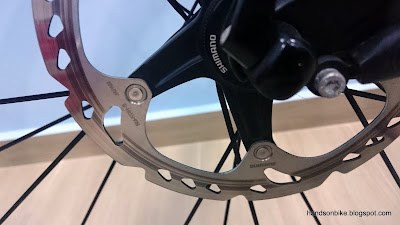Usually, when there is a squealing noise from the brakes, it means that the brake pads or brake rotors have been contaminated with oil. Most of the time, this contamination comes from the dirt and oil on the roads, which is unavoidable. Other sources would be from dirty hands touching the brake rotor, and in rare cases, a leaking hydraulic brake.
Front Ice Tech rotor SM-RT81 which was installed 1.5 years ago.
The black marks on the braking surface are tell tale signs of oil on the rotors or brake pads.
Same rotor used on the rear Alfine 11 internal hub
The rear rotor also has black marks on the rotor braking surface
The standard procedure for cleaning the brake pads and rotors are:
Brake Pads:
1) Remove brake pads from brake caliper.
2) Wipe clean brake pads with isopropyl alcohol.
3) Sand off top layer of brake pads, to remove glazed or contaminated layer.
4) Clean with isopropyl alcohol again.
Brake Rotor:
1) Remove brake rotor from hub.
2) Wipe clean brake rotor with isopropyl alcohol.
3) Sand off surface of brake rotor. This removes the scratched surface of the rotor and "resets" the microscopic surface of the rotor.
4) Clean with isopropyl alcohol again.
This usually works to eliminate the squealing noise of the brakes as both the brake pad and brake rotor surfaces have been restored. At the same time, this also means that there is a need to break in the brake surfaces again, in order to get proper braking force.
However, I decided to change the brake pads to new Ice-Tech disc brake pads, as I wanted to see how the finned brake pads will look. I had gotten these brake pads long ago, but did not change them earlier as the original brake pads from the brake calipers were still working fine.
Now that the original brake pads are getting old, and are contaminated with oil, it is the perfect chance to change to these Ice-Tech brake pads.
Shimano Ice-Tech Disc Brake Pads, with finned surfaces to help keep the brake temperature low.
Compatible with the models as listed above. Each set is for 1 brake caliper, so you need 2 sets for a bike.
These are resin pads, and come with the parts as shown.
Weigh 22 grams for the pair of brake pads
The aluminium fins of the brake pad backing are exposed to air, acting like a heat sink to quickly transfer heat away from the brake pads.
Brand new look before installation.
Original look of the brake caliper with standard brake pads...
...new look with the Ice-Tech brake pads! Looks more aggressive with the finned brake pads.
From further away, these finned brake pads are not that obvious though.
Same for the rear, the picture before the change...
...after the change! Not much difference la...
Nice look when in close up
When viewed from far, the finned brake pads are not really visible
In this case, there is no need for finned brake pads on this Avanti Inc 3 commuting bike as the bike is not going downhill, and there is no chance of the brake temperatures reaching a level that requires finned brake pads. For me, it is more of changing the look of the brake calipers.
The conclusion is that the brake calipers and brake pads are not really visible and it does not really change the look of the bike. The only advantage that I have from this change is getting to use new brake pads, which stop well and are not squealing.
















